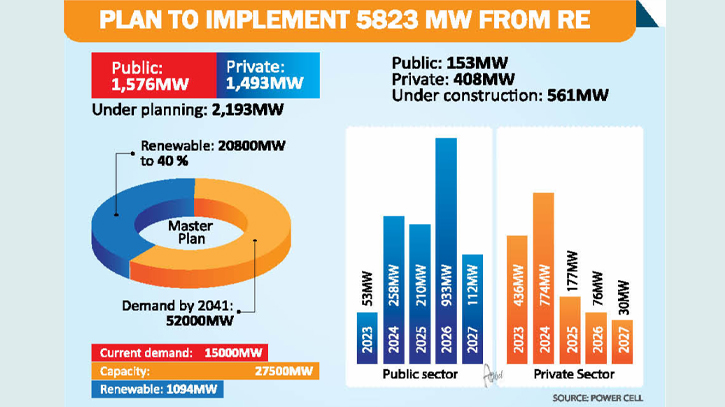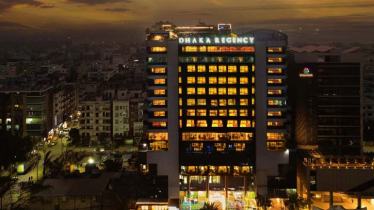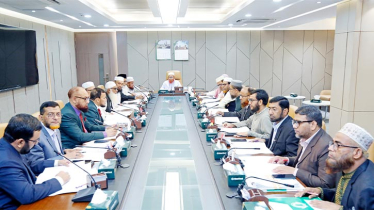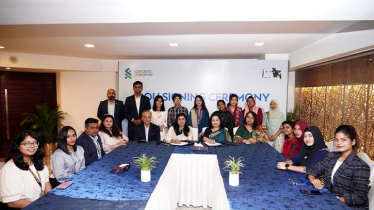
Photo : Messenger
The government's urgency in generating a significant volume of electricity without ensuring an adequate fuel supply and the upgrading of the national grid results in approximately 60 percent of the capacity remaining unused.
Against the backdrop of prevailing situation, the Power Division has set ambitious targets to establish large renewable energy-based plants, even though the national grid is incapable of efficiently transmitting variable electricity.
Concerns arise that the plan to generate 3,069MW from renewable energy will also go to waste if the national grid is not upgraded to handle variable power.
According to Power Cell, the planning wing of the Power Division, the government aims to implement 3,069MW of power from renewable energy sources by 2027. Of these, 1,576MW will be implemented by the government, and the remaining 1,493MW will be implemented by the private sector.
However, the government plans to generate 53MW in 2023, 258MW in 2024, 210MW in 2025, 933MW in 2026, and 122MW in 2027. Meanwhile, the private sector aims to generate 436MW in 2023, 774MW in 2024, 177MW in 2025, 76MW in 2026, and 30MW in 2027.
Muhammad Hossain, Director General of Power Cell, told the Daily Messenger, "The plan is certainly achievable. In fact, we have no choice but to rely on renewable energy in the future. We have already been successful with home solar."
Nitai Pada Saha, CEO of the Rural Services Foundation, told the Daily Messenger, “There are significant challenges in implementing these plants. The private sector is hesitant to negotiate with the government. If the government can establish a fixed rate for six months or a year, private entrepreneurs may become more interested in investing in renewable energy.”
Financial institutions do not consider solar as an essential product, resulting in high interest rates on inverters. Independent power producers (IPPs) enjoy a 1 percent interest rate, while inverter importers have to pay a 40 percent rate, which poses a significant challenge for investors, according to him.
Engineer Zakaria Jalal, Head of Planning at Bashundhara Group, said, “The reality is that renewable energy will be the next fuel for power generation. I believe the plan is achievable if the government can improve the national grid.”
Moreover, the government needs to embrace modern technology for the transmission of variable electricity, according to his perspective. He also emphasises the importance of implementing a long-term policy spanning 20 years, rather than relying on short-term policies, due to significant challenges such as land availability, labour force, and investment.
As per the master plan, the country's electricity demand is projected to reach 52,000MW by 2041, while the generation capacity is expected to be 600,000MW, with 40 percent, or 24,000MW, coming from renewable energy sources (RE).
Presently, 1,094MW is generated from RE, and the master plan aims to increase this to 10,000MW by 2030. However, the existing grid infrastructure is outdated and inadequate to handle the current 25,500MW capacity.
Under the revised policy, local investors will receive special incentives, and foreign investors will benefit from tax-free investment facilities. Foreign loans will be interest-free, and entrepreneurs will enjoy tax-free income for three years. Foreign citizens will be recruited in accordance with the Renewable Energy (RE) Investment Board.
Additionally, 50 percent of their income will be directed towards retirement savings. Both foreign and local loans will enjoy similar benefits, and distribution companies will not face penalties if they cannot meet seasonal obligations on time.
Joint Secretary of the Power Division, Muhammad Alauddin, said, “Solar power is not conventional electricity; it exhibits frequent fluctuations that the current grid infrastructure cannot handle in large quantities. It can tolerate up to 10 percent fluctuations at best, but not more than that.”
He adds that while the master plan for the power sector suggests adding 10 percent of power to the national grid from renewable sources, transmitting a substantial amount of solar power through the current weak grid is not feasible.
According to data from the Bangladesh Power Development Board (BPDB), the solar power capacity stands at approximately 1,200MW, with 461MW available from Solar Parks and around 350MW from Solar Rooftop installations.
Messenger/Disha








